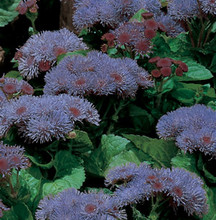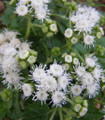 Loading... Please wait...
Loading... Please wait...Product Description
Ageratum MiniMound Series Blue Seeds
50 Seeds per packet
Clear Mid Blue
Mound forming, compact, excellent landscaping plant, green leaf, uniform colors
height - 12”
11 weeks to transplant, grow at 68-75 degrees.
Cultural Instructions:
Compact, well-branched and mounded habit in the garden. The need for less plant growth regulators means they can be produced with time and chemical savings. When PGRs are used, plants respond uniformly. Vigorous and early-blooming plants. Profuse top flowering for good colour show all season. Dark green-leafed, 12-in. (30-cm) plants perform best in full sun. .Ideal for borders and mass landscapes.
Plug Production
Media: Use a well-drained, disease-free plug media with a pH of 5.5 to 6.2 and EC about 0.75 mmhos/cm (1:2 extraction).
Sowing:
Moisten the media before sowing the seed. If media is watered after sowing, make sure seeds are not washed away. Cover the seed with a light layer of vermiculite.
Temperature
Germination: 72 to 75°F (22 to 24°C)
Cotyledon stage: 68 to 75°F (20 to 24°C)
True leaves: 65 to 72°F 18 to 22°C)
Hold plugs: 60 to 68°F (15 to 20°C)
Germination takes approximately 3 to 4 days in a germination chamber.
Fertilizer
As cotyledons expand, feed 50 ppm N in a nitrate form. When true leaves begin to develop, increase to 100 ppm.
Growth Regulators
No plant growth regulators are required.
Growing On to Finish Media
Use a well-drained, disease-free, soilless medium with a pH of 5.5 to 6.2 and a medium initial nutrient charge.
Temperature
Nights: 58 to 62°F (14 to 17°C) Days: 70 to 80°F (21 to 27°C)
Irrigation
Irrigate plants on an as-needed basis. Excess water will promote lush growth and tall plants, and will delay flowering. Do not allow plants to wilt severely, or leaves may burn and drop off.
Fertilizer
Ageratum are light feeders, so they do not require large applications of fertilizers. Feed at a rate of 100 to 150 ppm N from a balanced fertilizer. Excessive nutrient levels will produce lush growth and will delay flowering.
Crop Scheduling
Ageratum is usually scheduled as a 9 to 10-week crop. Use of excessive growth regulators and/or less than optimal cultural practices may delay flowering and extend the crop time to as much as 12 weeks.
Common Problems
Insects: Whitefly, thrips, aphids
















